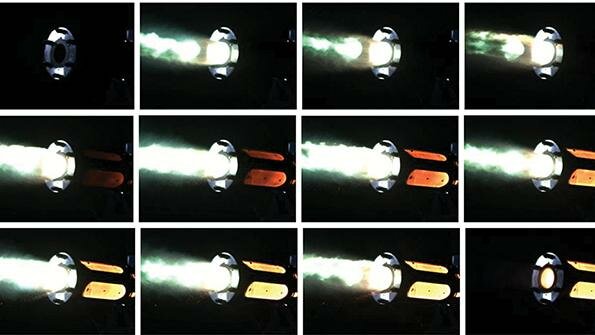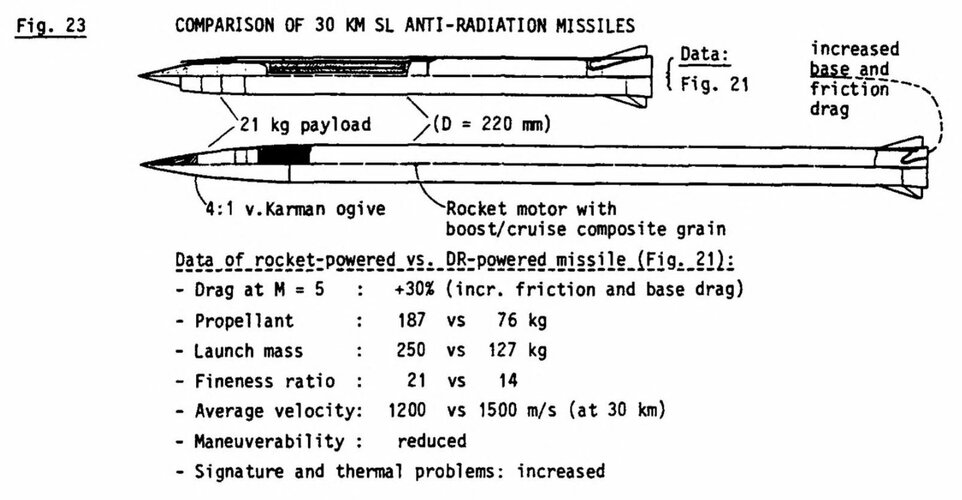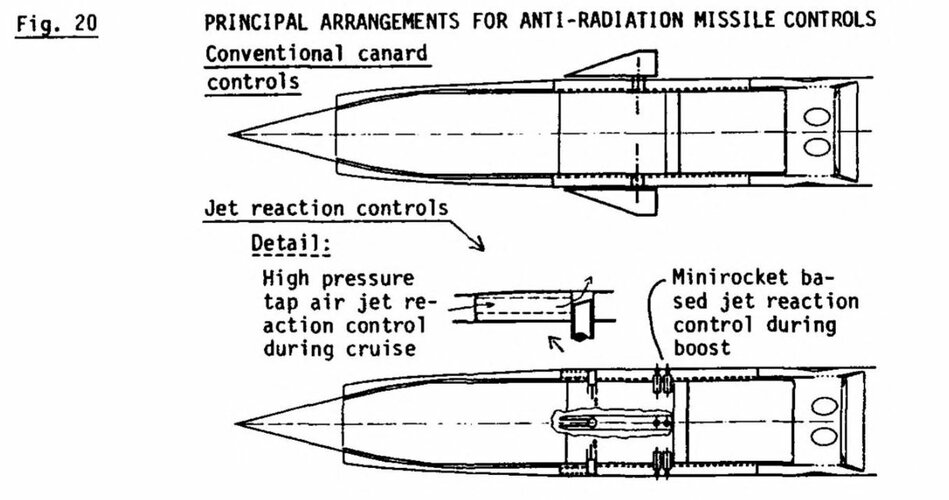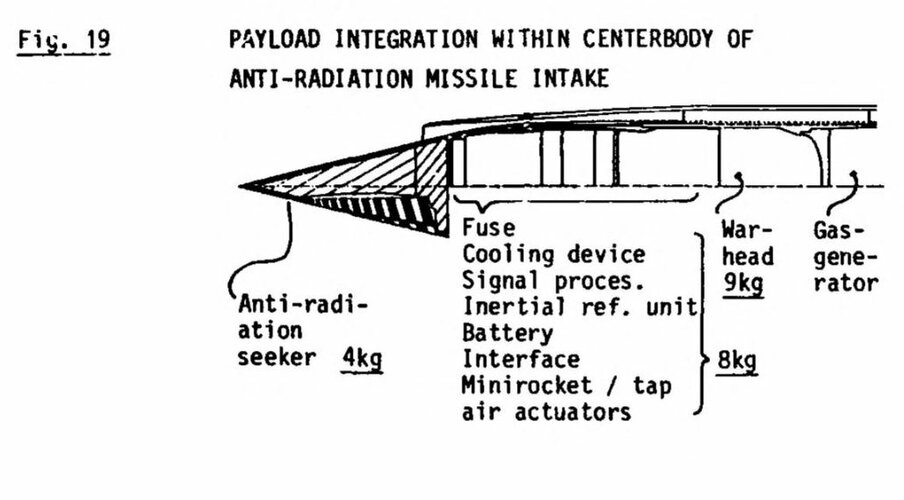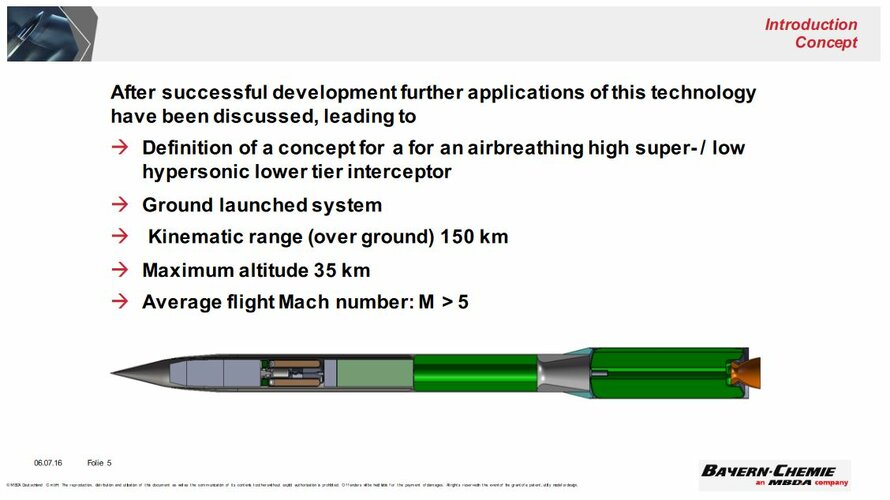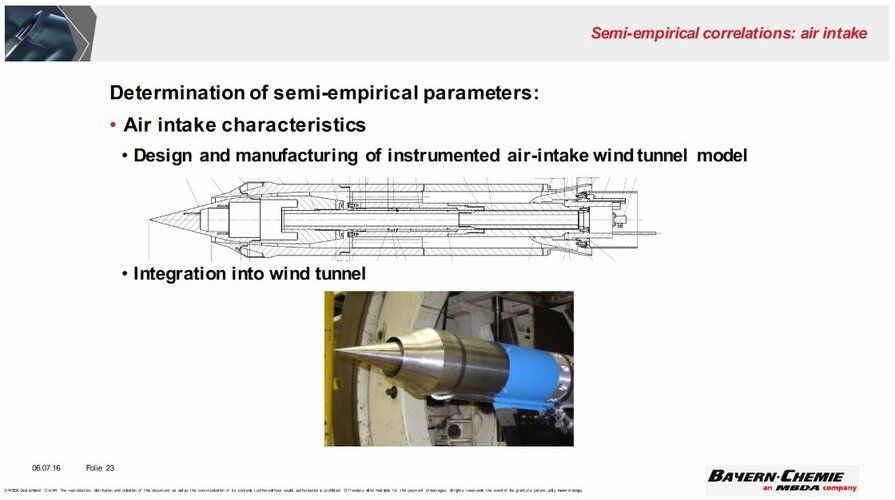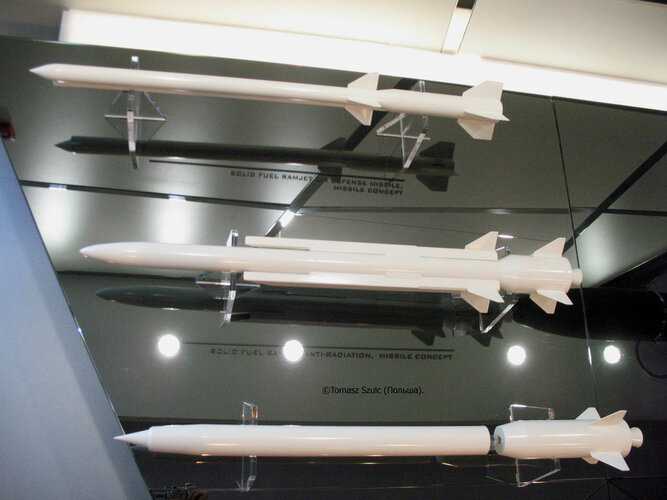Details have emerged of a ballistic-missile-defense interceptor concept designed by Germany’s Bayern-Chemie and using the throttleable ducted rocket (TDR) propulsion technology developed for Europe’s MBDA Meteor beyond-visual-range air-to-air missile. A feasibility study of the lower-tier endoatmospheric interceptor has been completed by the company, funded by the German defense procurement agency and including tests of key technologies. Work on the missile concept is continuing ...If you have an AWST account.
http://aviationweek.com/technology/ducted-rocket-missile-defense-interceptor-shows-promise
You are using an out of date browser. It may not display this or other websites correctly.
You should upgrade or use an alternative browser.
You should upgrade or use an alternative browser.
Bayern Chemie Ducted-Rocket Missile-Defense Interceptor
- Thread starter muttbutt
- Start date
So a kind soul has posted up the article and pics on another forum...so thanks to Bugler billy, link below.


Two burn tests, each of 35 sec., resulted in no damage to ceramic-matrix-composite combustion. Credit: Bayern-Chemie


Two burn tests, each of 35 sec., resulted in no damage to ceramic-matrix-composite combustion. Credit: Bayern-Chemie
Ducted-Rocket Missile-Defense Interceptor Shows Promise
Sep 7, 2015Graham Warwick | Aviation Week & Space Technology
Details have emerged of a ballistic-missile-defense interceptor concept designed by Germany’s Bayern-Chemie and using the throttleable ducted rocket (TDR) propulsion technology developed for Europe’s MBDA Meteor beyond-visual-range air-to-air missile.
A feasibility study of the lower-tier endoatmospheric interceptor has been completed by the company, funded by the German defense procurement agency and including tests of key technologies. Work on the missile concept is continuing internally, says Bayern-Chemie.
Information on the project to assess whether the TDR propulsion system could operate at an altitude of 35 km (115,000 ft.) and speeds exceeding Mach 5 emerged in papers presented at the American Institute of Aeronautics & Astronautics Propulsion & Energy conference in Orlando, Florida, in June.
“The Mach 5+ missile concept with throttleable ducted rocket propulsion was formulated to drive the TDR technology to velocity regimes beyond those that are currently covered by ramjet propulsion, for example Meteor,” says Karl Wieland Naumann, director of business development and strategy for Bayern-Chemie.
“The German defense ministry funded a feasibility study in 2011-14 to investigate some critical items like the air intakes and performance parameters, which delivered encouraging results. Currently we are doing some internal work to prepare for potential applications,” he says.
Producing continuous thrust, the TDR is an alternative to conventional missile propulsion systems that, after a short boost phase and second short sustain or pulse phase, can only rely on kinetic energy to intercept a target, Bayern-Chemie says.
Because the TDR propulsion system only works efficiently in supersonic flight, the ground-launched weapon has a first-stage booster to accelerate the interceptor to around Mach 2, where the second stage would take over and boost the missile to beyond Mach 5.
Following stage separation, an integral solid-propellant booster in the afterburner section of the TDR is ignited. After this booster tails off, an intake on the nose of the missile opens and air flows through an annular duct into the now-empty afterburner combustion chamber.
A gas generator containing oxygen-deficient solid propellant produces a fuel-rich gas that is injected via a blast tube into the afterburner chamber, mixed with the air and burned, the exhaust exiting through the shared rocket/ramjet nozzle to produce thrust.
Between the gas generator and ram-combustor is an interstage which houses an active valve that regulates the fuel mass flow. The rate at which fuel is produced is proportional to the pressure rise in the gas generator, the company says, so closing the valve increases fuel flow and thrust. To reduce fuel flow at high altitudes, a second set of blast tubes is opened by a one-shot pyrotechnic device.
Guide vanes at the entrance to the combustion chamber provide efficient mixing of the air and fuel. Port covers at the exit of these vanes protect the air duct from pressure oscillations and hot gases during second-stage booster operation. After booster tail-off, the covers are fragmented by a pyrotechnic device and ejected into the combustion chamber.
Under the funded feasibility study, Bayern-Chemie tested a model of the air intake in a tri-sonic wind tunnel in Cologne, Germany. The intake is opened by translating the compression cone backward, then an oblique shock system compresses and decelerates the air as it enters the annular duct.
Development resulted in an intake able to operate from Mach 3.5-5-plus, with an advanced boundary-layer bleed system to help start the inlet and a sensor system that enables the flight controller to adapt fuel mass flow into the combustion chamber to stability conditions at the intake.
The company also tested a carbon/silicon-carbide (C/SiC) combustion chamber for the ducted rocket. To withstand the temperatures inside and outside from both combustion and aerodynamic heating, a conventional metallic chamber would require internal and external thermal protection systems. This would increase the bore thickness and reduce the volume of propellant for the boost.
To maximize the integral booster’s size and push the Mach number at which the TDR takes over as high as possible, Bayern-Chemie developed a C/SiC combustion chamber without any thermal protection. Tests were conducted to see how the design withstands pressures, temperatures and erosion from the particle-laden combustion gas.
In two runs representing the climb (booster) and cruise (TDR) phases of an intercept, with an overall burn time of more than 60 sec., the simplified test chamber suffered no significant damage from erosion, a combustion temperature of 2,500K and static pressure of 6 bar, the company says. The tests suggest burn times of 120 sec. are achievable, which would widen the TDR’s operating regime, the company says.
At the Orlando conference, Bayern-Chemie presented the results of performance assessments for a TDR-powered lower-tier interceptor. This is a 150-km (93-mi.) range weapon with a 1.05-meter (3.4-ft.)-long, 0.5-meter-dia. first-stage booster that accelerates the missile to Mach 1.9 and 9,800 ft. for stage separation.
The second stage is 4.2 meters long, with an outside diameter of 0.45 meters. The integral booster housed in the afterburner chamber is 1.2 meters long. Simulations of five generic trajectories showed the TDR-powered missile met the kinematic requirements to intercept even maneuvering targets.
In three of the five trajectories simulated, the interceptor had residual propellant on board to provide additional thrust for end-game maneuvers. The other trajectories would require more advanced midcourse guidance, a larger gas generator and modified intake to improve performance, Bayern-Chemie says.
Attachments
Last edited by a moderator:
- Joined
- 9 October 2009
- Messages
- 21,129
- Reaction score
- 12,215
From the sound of things it's going to be an Anti-Ship / Anti-Invasion (stand off fire support) missile for outer island defence.
New missile eyed to guard Senkaku isles
8:29 pm, August 14, 2016
The Yomiuri Shimbun
The government intends to develop a new surface-to-ship missile for reinforcing the defense of remote islands, including the Senkaku Islands in Okinawa Prefecture, The Yomiuri Shimbun has learned.
The government aims to deploy the missile, which will have a maximum range of 300 kilometers, on Miyakojima and other major islands of the Sakishima islands. This will put the territorial waters around the Senkaku Islands within its range.
Funding for the development will be included in the Defense Ministry’s initial budget requests for fiscal 2017. The government aims to deploy the missiles around fiscal 2023.
China has repeatedly engaged in provocative actions around the Senkaku Islands, so the government aims to strengthen deterrence by reinforcing its capability for long-range attacks.
The new missile will be mounted on a vehicle, making it easy to transport and change positions. It will have a guidance system using the global positioning system (GPS) or other means, and be capable of striking targets, such as other countries’ warships deployed around remote islands, from nearby islands.
The National Defense Program Guideline, which was approved by the Cabinet in 2013, stipulates a policy of strengthening Japan’s capability to defend remote islands. Development of the new missile is part of these efforts.
The Senkaku Islands are about 170 kilometers from Ishigakijima island and Miyakojima island, where Ground Self-Defense Force units are scheduled to be stationed. The Senkaku Islands are also about 150 kilometers from Yonagunijima island, where a GSDF coastal monitoring unit was deployed in 2016.
The current surface-to-ship missile possessed by the GSDF, called the Type-12 Surface-to-Ship Missile, has a maximum range of just over 100 kilometers. Even if it is deployed on the islands, the current missile does not have sufficient capability to strike targets in territorial waters and contiguous zones around the Senkaku Islands.
Territorial waters are within 12 nautical miles (about 22 kilometers) from shore and contiguous zones are within 12 nautical miles from the territorial waters.
If the maximum range can be extended to 300 kilometers by developing the new missile, Japan will have sufficient capability to deter the approach of other countries’ warships toward territorial waters around the Senkaku Islands.
The new surface-to-ship missile would also be effective if a remote island is occupied.
When GSDF units conduct landing operations, they currently focus on naval gunfire from destroyers with a short firing range or dropping bombs from fighter jets. That involves a high risk of being counterattacked.
The new missile would make it possible to assist the GSDF landing units from nearby islands.
The government plans to develop the missile solely in Japan. It will use solid fuel, which requires advanced technology.
Solid fuel does not leak and is not volatile, making it possible to store the fuel for a long time. It is therefore harder to detect signs that missiles using such fuel will be fired, compared with missiles that use liquid fuel, which takes a long time to inject into the missiles.
The Defense Ministry expects the development of the new missile to boost the technological levels of domestic defense industries.
Voltzz
ACCESS: Secret
- Joined
- 10 April 2021
- Messages
- 394
- Reaction score
- 1,464
This paper by Bayern Chemie is behind a paywall, but it has some nice information on the design priciples behind the Throttleable Ducted Rocket used on the Meteor and some other applications for this engine. It also has a drawing of a Meteor-SAM using a booster similar to the ASTER:
and a sketch of an alternative integrated configuration for ARMIGER using a chin intake:An air defence variant could be easily derived from a BVRAAM missile like Meteor. Such a derivative could
feature both performance improvement and design simplification (cost reduction). With a design for container
launch, the hangers for aircraft carriage could be eliminated leading to a substantial reduction of the missile drag.
This would give an over proportional range improvement due to lower thrust demand and a shift of the TDR
operation into fuel lean regimes with enhanced specific impulse.
The integrated booster of a BVRAAM is sized for minimum launch speed of the aircraft and therefore, for
ground launch, a relatively simple tandem boost motor would be needed (Fig. 16).
Fig. 10 gives a comparison of modular and non modular concepts from a German Anti-radiation missile study,
where the integrated concept provides superior kinematic performance on the expense of increased interface
complexity and potential component interaction.
In case of an infrared seeker, a non modular chin air intake missile configuration can provide a superior missile
performance, if the significantly inclined seeker window forms part of the air intake compression surface well within
the capture stream tube and thus without generation of missile external wave drag.
Voltzz
ACCESS: Secret
- Joined
- 10 April 2021
- Messages
- 394
- Reaction score
- 1,464
The paper also has a integrated more optimized configuration for a ramjet-SAM using a circular nose-intake. Confusingly the exact same configuration was discussed in an older AGARD conference paper by Bayern-Chemie for a anti-radar missile. Both papers even use some of the same diagrams.This paper by Bayern Chemie is behind a paywall, but it has some nice information on the design priciples behind the Throttleable Ducted Rocket used on the Meteor and some other applications for this engine. It also has a drawing of a Meteor-SAM using a booster similar to the ASTER:
and a sketch of an alternative integrated configuration for ARMIGER using a chin intake:
Attachments
Voltzz
ACCESS: Secret
- Joined
- 10 April 2021
- Messages
- 394
- Reaction score
- 1,464
Voltzz
ACCESS: Secret
- Joined
- 10 April 2021
- Messages
- 394
- Reaction score
- 1,464
Found this picture of three MBDA ramjet concepts presented at ILA 2014 here
The bottom one looks most like the ducted-rocket interceptor but unfortunately the label is not in the picture. The top one is labeled as an air defense missile but it seems to use a chin-intake instead of the circular nose-intake. I also wonder if these really are solid fuel ramjet or just called that, because variable-flow-ducted-rocket is too confusing.
I searched for more pictures of the MBDA stand at ILA 2014 but could not find any other angles of these models. If anyone has more information or more pictures that would be appreciated.
The bottom one looks most like the ducted-rocket interceptor but unfortunately the label is not in the picture. The top one is labeled as an air defense missile but it seems to use a chin-intake instead of the circular nose-intake. I also wonder if these really are solid fuel ramjet or just called that, because variable-flow-ducted-rocket is too confusing.
I searched for more pictures of the MBDA stand at ILA 2014 but could not find any other angles of these models. If anyone has more information or more pictures that would be appreciated.
Attachments
Scott Kenny
ACCESS: Above Top Secret
- Joined
- 15 May 2023
- Messages
- 8,641
- Reaction score
- 9,409
Eh, maybe?Now that the Meteor is a mature design in production and in service what are the odds that a ground and/or sea launched version will be developed.
Sea launchers would be competing with ESSM and Aster, tough market to compete with. However, I could see some success with an ESSM size missile that has range on par with an SM2ER or SM6.
Ground launchers may be a better option. A relatively cheap BMD-capable missile would be competing against PAC-3MSE and THAAD, both of which are expensive missiles.
- Joined
- 16 April 2008
- Messages
- 9,008
- Reaction score
- 12,686
Sea launchers would be competing with ESSM and Aster, tough market to compete with. However, I could see some success with an ESSM size missile that has range on par with an SM2ER or SM6.
Not sure Meteor would achieve that though. It only slightly outsticks AIM-120D, by most accounts. I would not be surprised if ESSM Mk2 outranges it from the surface.
Scott Kenny
ACCESS: Above Top Secret
- Joined
- 15 May 2023
- Messages
- 8,641
- Reaction score
- 9,409
The one with the large diameter upper stage? Maybe. Pretty sure it will outrange an SM2MR, which would still be a decent option, since you could pack them so much tighter and include more SM3, SM2ER, and SM6s even if the Sea Meteor doesn't reach as far as SM2ER.Sea launchers would be competing with ESSM and Aster, tough market to compete with. However, I could see some success with an ESSM size missile that has range on par with an SM2ER or SM6.
Not sure Meteor would achieve that though. It only slightly outsticks AIM-120D, by most accounts. I would not be surprised if ESSM Mk2 outranges it from the surface.
Voltzz
ACCESS: Secret
- Joined
- 10 April 2021
- Messages
- 394
- Reaction score
- 1,464
From this paper and relevant to the range discussion:This paper by Bayern Chemie is behind a paywall, but it has some nice information on the design priciples behind the Throttleable Ducted Rocket used on the Meteor and some other applications for this engine. It also has a drawing of a Meteor-SAM using a booster similar to the ASTER:
This also assumes that the intake design of the Meteor stays the same. A containerized SAM could gain range from transitioning away from the two-intake design optimized for conformal carriage. A design with 4 smaller intakes should be more optimized for the SAM roll while not increasing the containers dimensions.An air defence variant could be easily derived from a BVRAAM missile like Meteor. Such a derivative could
feature both performance improvement and design simplification (cost reduction). With a design for container
launch, the hangers for aircraft carriage could be eliminated leading to a substantial reduction of the missile drag.
This would give an over proportional range improvement due to lower thrust demand and a shift of the TDR
operation into fuel lean regimes with enhanced specific impulse.
The integrated booster of a BVRAAM is sized for minimum launch speed of the aircraft and therefore, for
ground launch, a relatively simple tandem boost motor would be needed (Fig. 16). A tandem booster with a
moderate thrust level combined with a substantial burn time would lead to a 1st stage burnout at appr. M 1.6 in 3500
m altitude. Subsequent operation of the integral booster would result in transition at M > 2.5 in > 4000 m of
altitude, enabling ample acceleration capability of the TDR. The tandem booster for a BVRAAM ( diam. . ~ 178
mm) as shown in Fig. 17 has a diam. ~ 330 mm and a length ~ 1.1 m including adapter / conical section (about 25°).
A design with 4 smaller intakes should be more optimized for the SAM roll while not increasing the containers dimensions.
That's what I was thinking too.
Scott Kenny
ACCESS: Above Top Secret
- Joined
- 15 May 2023
- Messages
- 8,641
- Reaction score
- 9,409
And if they're going to delete the hangers needed for aircraft launch, spending a little time redesigning the intakes to 4x smaller ones is probably trivial...From this paper and relevant to the range discussion:This paper by Bayern Chemie is behind a paywall, but it has some nice information on the design priciples behind the Throttleable Ducted Rocket used on the Meteor and some other applications for this engine. It also has a drawing of a Meteor-SAM using a booster similar to the ASTER:
This also assumes that the intake design of the Meteor stays the same. A containerized SAM could gain range from transitioning away from the two-intake design optimized for conformal carriage. A design with 4 smaller intakes should be more optimized for the SAM roll while not increasing the containers dimensions.An air defence variant could be easily derived from a BVRAAM missile like Meteor. Such a derivative could
feature both performance improvement and design simplification (cost reduction). With a design for container
launch, the hangers for aircraft carriage could be eliminated leading to a substantial reduction of the missile drag.
This would give an over proportional range improvement due to lower thrust demand and a shift of the TDR
operation into fuel lean regimes with enhanced specific impulse.
The integrated booster of a BVRAAM is sized for minimum launch speed of the aircraft and therefore, for
ground launch, a relatively simple tandem boost motor would be needed (Fig. 16). A tandem booster with a
moderate thrust level combined with a substantial burn time would lead to a 1st stage burnout at appr. M 1.6 in 3500
m altitude. Subsequent operation of the integral booster would result in transition at M > 2.5 in > 4000 m of
altitude, enabling ample acceleration capability of the TDR. The tandem booster for a BVRAAM ( diam. . ~ 178
mm) as shown in Fig. 17 has a diam. ~ 330 mm and a length ~ 1.1 m including adapter / conical section (about 25°).
kqcke for you
PUMA PUMA PUMA
- Joined
- 3 November 2022
- Messages
- 992
- Reaction score
- 1,226
Yeah which could be a good alternative. Thought does it fit like essm with 4 missiles per cell?
Scott Kenny
ACCESS: Above Top Secret
- Joined
- 15 May 2023
- Messages
- 8,641
- Reaction score
- 9,409
If they're doing some redesigning anyways, I would make sure they could fit it 4 per cell!Yeah which could be a good alternative. Thought does it fit like essm with 4 missiles per cell?
kqcke for you
PUMA PUMA PUMA
- Joined
- 3 November 2022
- Messages
- 992
- Reaction score
- 1,226
You got me with anywaysIf they're doing some redesigning anyways, I would make sure they could fit it 4 per cell!Yeah which could be a good alternative. Thought does it fit like essm with 4 missiles per cell?
When can i buy?^^
Last edited:
kqcke for you
PUMA PUMA PUMA
- Joined
- 3 November 2022
- Messages
- 992
- Reaction score
- 1,226
Tought then it could be a very potent weapon and a good alternative for essm tought could we throw the Iris-T SLX Seeker head on it? So IR and Radar?
Last edited:
Voltzz
ACCESS: Secret
- Joined
- 10 April 2021
- Messages
- 394
- Reaction score
- 1,464
Yeah which could be a good alternative. Thought does it fit like essm with 4 missiles per cell?
NoIf they're doing some redesigning anyways, I would make sure they could fit it 4 per cell!Yeah which could be a good alternative. Thought does it fit like essm with 4 missiles per cell?
Both the Meteor SAM described and the Bayern Chemie Ducted-Rocket Interceptor design are depicted with boosters of similar size as the ASTER 15 and second-stages also of similar size to ASTER . On both missile designs the estimated range (150km) exceeds the range of the ASTER 30 an area air defence missile and matches the range of the SM-2 missile. All the missile fit only 1 per cell. the quad-packable ESSM and CAMM-ER have ranges around 50km. These are different missile categories.
Even if you removed the first stage and only used the integral booster these missiles wouldn't be quad-packable. And i have severe doubts that it would be possible to decrease their size substantially. Ducted-Rocket dimensions are constrained by the diameter of the gas-generator plus the air-intake. The control-valve in the generator necessary to make the missile throttleable are extremely complicated and hard to miniaturize. Smaller ramjet munitions basically always use a conventional solid-fuel-ramjet.
kqcke for you
PUMA PUMA PUMA
- Joined
- 3 November 2022
- Messages
- 992
- Reaction score
- 1,226
Solution is we just make a replacement for both out of it. Take the Aster 30 Booster the best they got and strap the modefied meteor in the best case with dual sensor on it. Case closed
- Joined
- 16 April 2008
- Messages
- 9,008
- Reaction score
- 12,686
Solution is we just make a replacement for both out of it. Take the Aster 30 Booster the best they got and strap the modefied meteor in the best case with dual sensor on it. Case closed
The Aster upper stage is very good itself. It's optimized for something a bit different than Meteor -- extreme maneuverability in the end game for likely hit-to-kill performance (hence the Pif-Paf side-thrusters). But the really light dart plus a very big booster means it goes plenty far downrange already.
kqcke for you
PUMA PUMA PUMA
- Joined
- 3 November 2022
- Messages
- 992
- Reaction score
- 1,226
I know. Tought if we maybe make an even better booster, have many parts shared with meteor and upgrade meteor itself to we could get a very good SAM which could function as an evolution of Aster 30. Also both have good and bad things but i think the tradeoff wouldn't be bad
Scott Kenny
ACCESS: Above Top Secret
- Joined
- 15 May 2023
- Messages
- 8,641
- Reaction score
- 9,409
If the booster stage of the Ducted-Rocket Interceptor is no more than 10"/255mm in diameter, they're theoretically quad-packable. Meteor is right at that size as the upper stage.Yeah which could be a good alternative. Thought does it fit like essm with 4 missiles per cell?NoIf they're doing some redesigning anyways, I would make sure they could fit it 4 per cell!Yeah which could be a good alternative. Thought does it fit like essm with 4 missiles per cell?
Both the Meteor SAM described and the Bayern Chemie Ducted-Rocket Interceptor design are depicted with boosters of similar size as the ASTER 15 and second-stages also of similar size to ASTER . On both missile designs the estimated range (150km) exceeds the range of the ASTER 30 an area air defence missile and matches the range of the SM-2 missile. All the missile fit only 1 per cell. the quad-packable ESSM and CAMM-ER have ranges around 50km. These are different missile categories.
Even if you removed the first stage and only used the integral booster these missiles wouldn't be quad-packable. And i have severe doubts that it would be possible to decrease their size substantially. Ducted-Rocket dimensions are constrained by the diameter of the gas-generator plus the air-intake. The control-valve in the generator necessary to make the missile throttleable are extremely complicated and hard to miniaturize. Smaller ramjet munitions basically always use a conventional solid-fuel-ramjet.
Think "Super ESSM," not "ASTER with a ramjet"
kqcke for you
PUMA PUMA PUMA
- Joined
- 3 November 2022
- Messages
- 992
- Reaction score
- 1,226
Or we try to create a Version which you can fit into a launcher if pac-3 mse. So 5.2m long and max diameter of 304mm. Got more space and you have a big pool of potential buyer. The same flk could be offered as Aster with ramjet to or super essm.
Found the paper, free-to-read .....Bayern Chemie Powerpoint with a bunch of information on the Ducted-Rocket Interceptor
Similar threads
-
-
The Timely Warning and Interception with Space-based TheatER surveillance (Twister)
- Started by Grey Havoc
- Replies: 15
-
Multi-Object Kill Vehicle (MOKV)
- Started by marauder2048
- Replies: 40
-
Ground or Sea Launched Meteor missile
- Started by PMN1
- Replies: 7
-

